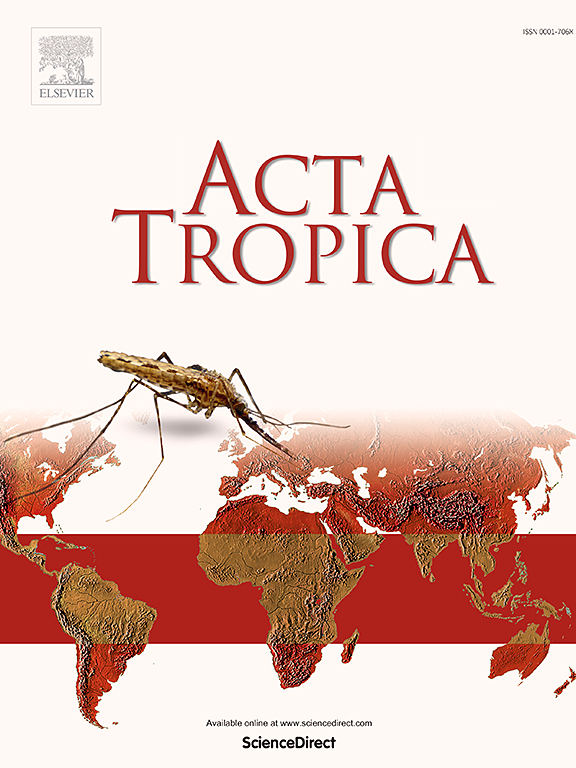Aedes albopictus responses to transfluthrin-impregnated polyester fabric in a semi-field system at different time periods
IF 2.1
3区 医学
Q2 PARASITOLOGY
引用次数: 0
Abstract
Volatile pyrethroid spatial repellents produce airborne chemicals that cause insect repellency and provide personal protection to human users. This study investigated the effect of a passive emanator fabric on the human landing catch (HLC) of Aedes albopictus in a semi-field system (SFS) as well as post-exposure blood-feeding behavior, fecundity, and egg hatchability. A polyester fabric measuring 1029 cm2 impregnated with 2.5 g/m2 transfluthrin (TFT) (6.8 %, w/v) was attached to a black-screened vest to simulate insecticide-treated clothing. Two collectors wearing treated polyester fabric (TFT-P) or untreated fabric conducted HLC from opposite test arenas during morning (06:00–08:00 h) and evening (18:00–20:00 h) trials for 12 days. Recaptured surviving mosquitoes were provided a blood meal for 120 min. The protective efficacy—the percentage reduction of HLC in treatment compared to control—of TFT-P was 60.73 % during the morning trials compared to 31.97 % during the evening trials. Blood feeding was moderately reduced in exposed (37.5 % fed) and unexposed (67.7 % fed) mosquitoes during the morning trials. Similarly, egg hatchability was significantly low in exposed batches (31.2 % hatched) compared to the unexposed (54.5 % hatched) from the morning trials, but not the evening trials. The results highlighted the effect of trial time on TFT-P efficacy, mosquito feeding behavior, and egg hatchability. TFT-P could provide personal protection against Ae. albopictus by preventing bites and offering community protection by reducing feeding propensity. Further open-field tests and evaluations against other mosquito species are needed before public use.
半现场试验系统中不同时段白纹伊蚊对浸渍氟氯菊酯聚酯织物的反应。
挥发性拟除虫菊酯空间驱蚊剂产生空气传播的化学物质,引起驱虫,并为人类使用者提供个人保护。本研究研究了被动式辐射织物对半场系统(SFS)白纹伊蚊人类着陆捕获量(HLC)的影响,以及暴露后白纹伊蚊的吸血行为、繁殖力和卵孵化率的影响。将1029 cm2的涤纶织物浸渍2.5 g/m2的全氟菊酯(TFT) (6.8%, w/v)附着在一件黑屏背心上,以模拟经过杀虫剂处理的衣服。两名收集者穿着处理过的涤纶织物(TFT-P)或未处理过的织物,在上午(06:00-08:00 h)和晚上(18:00-20:00 h)从相反的测试场所进行hplc试验,为期12天。对捕获的活蚊给予120 min血餐。TFT-P的保护效果(处理后的HLC比对照组减少百分比)在早晨试验中为60.73%,而在晚上试验中为31.97%。暴露蚊(37.5%采食)和未暴露蚊(67.7%采食)的采血量在上午试验期间差异显著,而在晚上试验期间差异不显著。同样,与早晨试验的未暴露批次(54.5%孵化)相比,暴露批次的鸡蛋孵化率(31.2%孵化)显著低,但晚上试验的鸡蛋孵化率不高。结果表明,试验时间对TFT-P药效、蚊虫取食行为和卵孵化率均有影响。TFT-P可以提供个人对Ae的保护。预防白纹伊蚊叮咬,并通过减少摄食倾向提供社区保护。在公开使用之前,需要对其他蚊子种类进行进一步的露天试验和评估。
本文章由计算机程序翻译,如有差异,请以英文原文为准。
求助全文
约1分钟内获得全文
求助全文
来源期刊

Acta tropica
医学-寄生虫学
CiteScore
5.40
自引率
11.10%
发文量
383
审稿时长
37 days
期刊介绍:
Acta Tropica, is an international journal on infectious diseases that covers public health sciences and biomedical research with particular emphasis on topics relevant to human and animal health in the tropics and the subtropics.
 求助内容:
求助内容: 应助结果提醒方式:
应助结果提醒方式:


